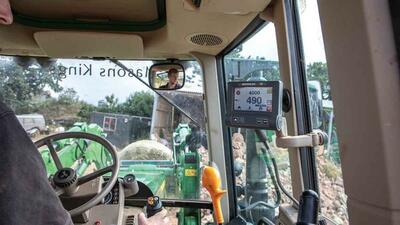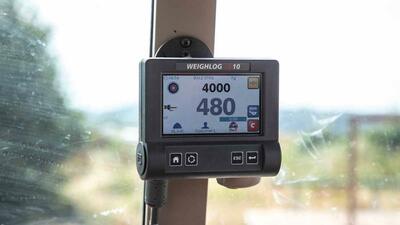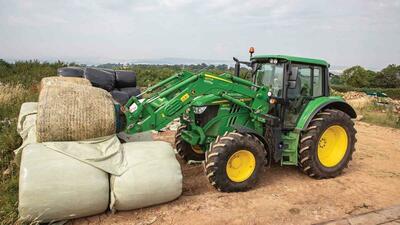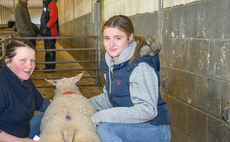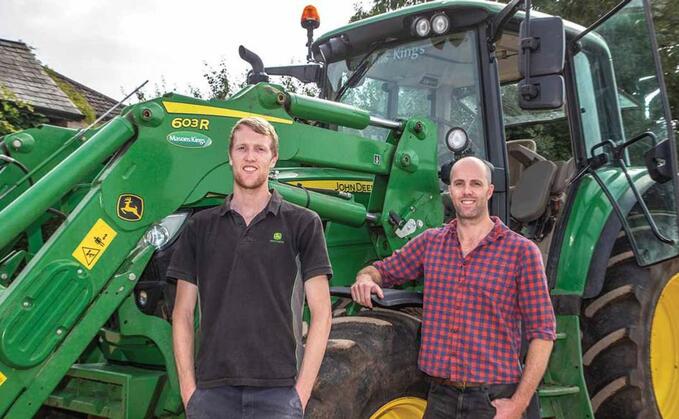
When it comes to materials handling, dairy farming brothers Steve and Sam Middleton have chosen a tractor and loader combination over a telehandler. Geoff Ashcroft reports.
Steve Middleton says: "Apart from the cost of buying another power unit, a telehandler is just too specialised and will not do as much work as a tractor. Adding an on-board weighing system to our tractor and loader has given us all the capability we need for materials handling."
Based at Higher Mallocks Farm, Woodbury, near Exeter, Devon, R.M. and S.J. Middleton runs a 250-cow dairy herd with followers and beef cattle, on 270 hectares. Grass is complimented by maize and wholecrop forage, with crimped grain finding its way into the ration.
By its own admission, the farm is not chasing high yields, but looking for a consistent 7,500-litre herd average along with milk quality.
"Attention to detail is important, but so are costs," he says. "And cost is one of the reasons why we do not use a mixer wagon for our rations. We choose to blend ration ingredients using the tractor and loader.
"We mix about 10 tonnes each day and feed half in the morning and half in the afternoon. And having on-board weighing, we can create a consistent and repeatable ration."
The farm moved to on-board weighing about 10 years ago, by retro-fitting an MX system to the farm's loader tractor, a JD6310 and MX loader. It has proved such a beneficial system that when the farm swapped one of its other tractors for an ex-demo JD6125M last year from local dealer Masons Kings, it made sure the loader was fitted with on-board weighing.
"RDS came out to fit the system to our 6125M and 603R loader," says Steve. "It was properly calibrated and checked, and we were shown how to set the Weighlog for our attachments and our rations."
The Alpha10 Weighlog system uses a 11cm (4.3in) colour touchscreen in the cab, with measurement taken through the loader's hydraulic system, using a preset and calibrated lift height.
Sam Middleton says: "It is very easy to use. Once I have selected the correct attachment in the Weighlog screen, and checked the tare weight is at zero, I just need to pick up material and raise the loader arms.
"At the correct position, the system beeps to stop me lifting any higher while it takes a static weight reading. It takes a second or two, and then I push a button on the joystick to transfer the payload into the Weighlog control screen."
Said to be accurate to +/- 2 per cent, the Weighlog displays its weight in 10kg increments.
"Having the ability to weigh every part of our rations has just been a logical and sensible process for us," he says.
"Most dairy farms would use their feeder wagon scales for weighing - but we do not have a feeder wagon.
"When mixing rations, I set a total amount for each ingredient, then use the loader to count down to zero with every bucketful. All I need to do is watch the weight come tumbling down and move onto the next ingredient."
The farm has a range of attachments for use with the loader, including pallet forks, bale spike, muck grab, general purpose bucket, shear grab and bale squeezer. All have been weighed and their details entered into the Weighlog system.
There are compromises. Sam adds that the size of modern tractors makes it difficult to see the headstock when changing attachments, despite the lofty viewpoint from the cab.
"The larger bonnet makes it harder to see down to the headstock," he says.
"But there is a good all-round view from the cab. It is better than being sat on one side of a handler."
Steve thinks the answer is to create a raised banking with a flat top, where attachments can be stored when not in use.
"This would mean we could pick-up attachments from above ground-level - and then it would be easier to see past the front of the tractor," says Steve.
The 603R John Deere loader is not short of muscle. The brothers say up to three fertiliser bags can be easily handled, and with parallel lift, palleted loads are easily removed from delivery trucks.
"We do not need to fill lorries with grain, so having extra lift height, or a toe-tip bucket, is an expense we do not need," he adds.
He says that farm buildings do test manoeuvrability of the tractor and loader, though the Middletons still have the smaller JD6310 and MX loader should they need to downsize for any particularly tight spots.
"The only real benefit of a telehandler would be manoeuvrability around the yard and in low, tight buildings - and fortunately, our tractor and loader will just about fit our sheds. Though we might struggle with a bigger tractor and loader.
"And with the Weighlog system fitted, we do not see the need to ever move away from a tractor and loader."

